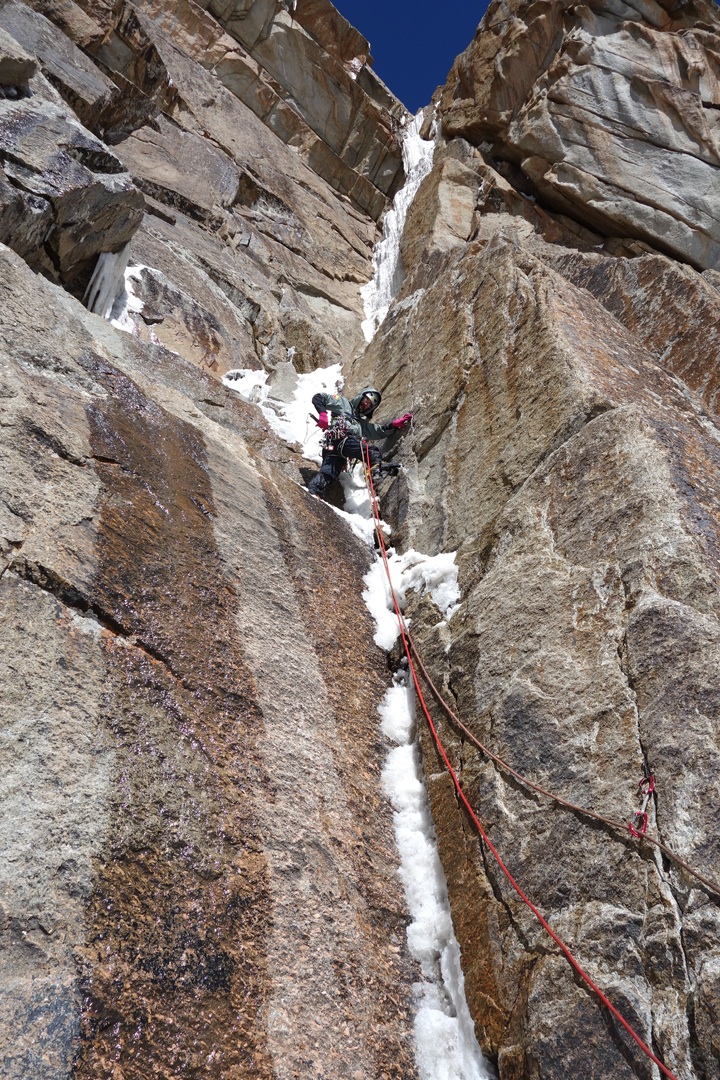Kyzyl Asker, East-Southeast Face, War and Peace
Asia, China, Xinjiang, Western Kokshaal-too
 In 2009, Sergey Nilov and I were part of a relatively large Belorussian-Russian expedition with the goal of a new route on Kyzyl Asker (5,842m). As an acclimatization climb we made a new route on the northwest face of beautiful Pik Vernyi (AAJ 2010). It was a great ascent, which we enjoyed very much. Later, Sergey Nilov, Sergey Mikhailov, and I tried a new line on the ca 1,150m face to the right of the Russian route on Kyzyl Asker’s southeast face (Mikhailov-Odintsov-Ruchkin 2007). The weather was very bad and we eventually ran out of time, 300m from the top. In the intervening years we dreamed about returning to finish this climb.
In 2009, Sergey Nilov and I were part of a relatively large Belorussian-Russian expedition with the goal of a new route on Kyzyl Asker (5,842m). As an acclimatization climb we made a new route on the northwest face of beautiful Pik Vernyi (AAJ 2010). It was a great ascent, which we enjoyed very much. Later, Sergey Nilov, Sergey Mikhailov, and I tried a new line on the ca 1,150m face to the right of the Russian route on Kyzyl Asker’s southeast face (Mikhailov-Odintsov-Ruchkin 2007). The weather was very bad and we eventually ran out of time, 300m from the top. In the intervening years we dreamed about returning to finish this climb.
In July we were back in Kyrgyzstan. A Nissan Patrol delivered Dmitry Grigoriev, Sergey Nilov, and me to a point between Bivachnoe Lake and the Kyzyl Asker Glacier. As an acclimatization climb we traversed four summits on the ridge east of the glacier. Our aim was to spend three nights above 4,500m. Starting to the north, we climbed over Pik Beggar (4,640m), Pik Ecstasy (4,720m), and Pik Yurnos (4,720m) to the summit of Pik Gronky (5,080m). From there we retraced our steps to the col before Yurnos and descended to the Komorova Glacier, where we cached gear that we would take to Kyzyl Asker. Later, it took us two days to ascend the Komorova Glacier and cross Window Col to establish camp below the east-southeast face.
Having now made two visits to this region, we can conclude that the weather is unstable: We have never experienced more than four consecutive days of fine weather, yet never had bad weather more than three days in a row. Compared to 2009 there was much less snow on the glacier and the bergschrund was far bigger. We started up our five-year-old line on August 1.
We first climbed four and a half pitches in a steep, narrow icefall to reach a small, sloping ledge, where we hacked out a site for our tent. We were forced to remain here at Camp 1 an extra day due to bad weather. Above, the ice axes were not needed until we reached Camp 4, 60m above our high point in 2009. The granite was good, with many cracks for cams, nuts, pitons, and Russian hooks. Unfortunately, almost all the wide cracks were choked with ice, so screws also were useful. At the end of each pitch we found and used our old belay/rappel anchors (mostly single 8mm bolts, the only gear left in place after our previous attempt). Camps 2, 3, and 4 were similar to Camp 1—all required four or five hours of ice excavation before gaining just enough space to erect our single tent. The weather was unstable throughout, and at both Camps 2 and 3 we spent an extra day before moving on.
On August 10 we fixed our last rope beneath three big snow mushrooms, which we knew lay on the crest of the northeast ridge. The summit was close, but we decided to wait to go for it early next morning. During the night the weather was awful, and I was annoyed with myself for not continuing the previous day. However, when we reached the top of the ropes the sun started to appear, warming us, and the glacier was visible far below. We crossed the crest and, moving together, reached the snow-capped rock summit. The weather was now surprisingly wonderful, and we spent an hour on top, during which we discovered a piece of rope, two nuts, and Salewa carabiners, which we later used for rappelling. The same day we managed to descend to Camp 1, and the following day were congratulating each other on the glacier. We named our route War and Peace. It gave 1,350m of climbing at an overall grade of 6B (or ED), 6b A2 M6. The rock is well featured with many cracks, and once started on the route you will never lose the line. We left only rappel anchors. We look forward to hearing that our line gets repeated.
Given the relatively small number of teams that have visited this area we were surprised and dismayed by the amount of garbage we saw. We brought only three ropes, but when we got to the glacier beneath Kyzyl Asker, we discovered a large bag, name-tagged Franz Walter, containing food, climbing gear, and two ropes. The ropes appeared to be in good condition, so we took them with us, fixing two or three above each camp. We collected ropes, gear, food, gas canisters, and other trash and took all this with us to base camp, and later out of the area by vehicle. [The team also found garbage from past Russian expeditions, including old cans and even plastic bottles containing fuel. When passing under Vernyi they found more rubbish, and at Bivachnoe Lake remnants of the 1988 USSR military expedition that made the first ascent of Vernyi. At the standard base camp below the Komorova Glacier, they found plastic originating from Poland. Franz Walter was a photographer with the Austro-German expeditions to this area in 2010 and 2011.]
Dmitry Golovchenko, Russia











